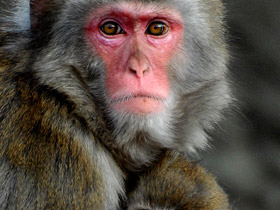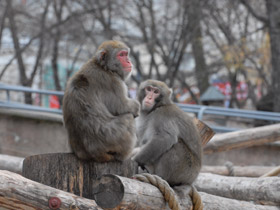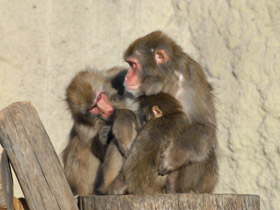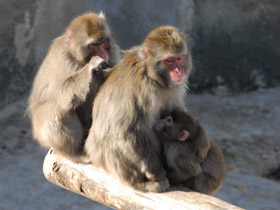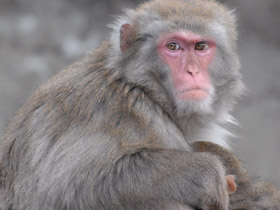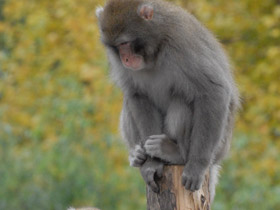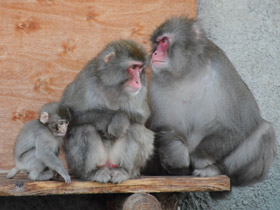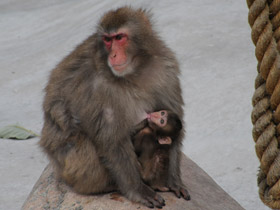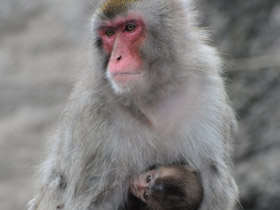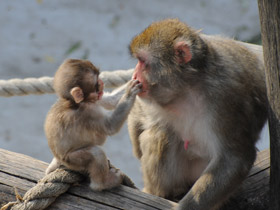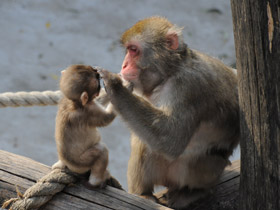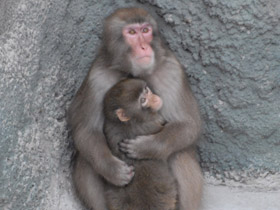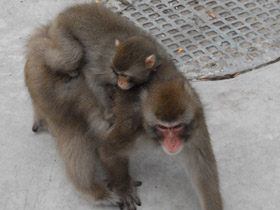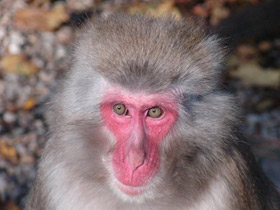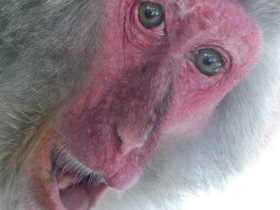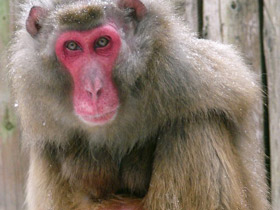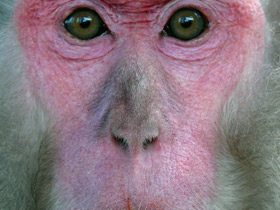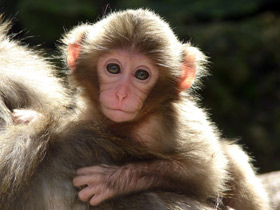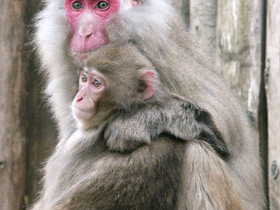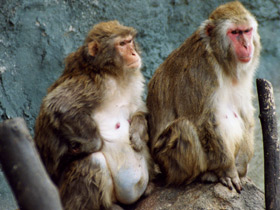The Japanese macaque (Macaca fuscata), the snow monkey
The Japanese macaque (Macaca fuscata), also known as the snow monkey, is a terrestrial Old World monkey species that is native to Japan. Colloquially, they are referred to as "snow monkeys" because some live in areas where snow covers the ground for months each year – no other non-human primate lives farther north, nor in a colder climate. Individuals have brownish grey fur, pinkish-red faces, and short tails. Two subspecies are known.
In Japan, the species is known as Nihonzaru (ニホンザル, a combination of Nihon 日本 "Japan" + saru 猿 "monkey") to distinguish it from other primates, but the Japanese macaque is very familiar in Japan — as it is the only species of monkey in Japan — so when Japanese people simply say saru, they usually have the Japanese macaque in mind.
Physical characteristics
The Japanese macaque is sexually dimorphic. Males weigh on average 11.3 kg (25 lb), while females average 8.4 kg (19 lb). Macaques from colder areas tend to weigh more than ones from warmer areas. The average height for males is 57.0 cm (22.4 in), while the average female height is 52.3 cm (20.6 in). The weight of their brain is approximately 95 g (3.4 oz). Japanese macaques have short stumps for tails that average 92.5 mm (3.64 in) in males and 79.1 mm (3.11 in) in females. The macaque has a pinkish face and posterior. The rest of its body is covered in brown or greyish hair. The coat of the macaque is well-adapted to the cold and its thickness increases as temperatures decrease. The macaque can cope with temperatures as low as −20 °C (−4 °F).
Macaques mostly move on all fours. They are semiterrestrial, with females spending more time in the trees and males spending more time on the ground. Macaques are known to leap. They are very good swimmers and have been reported to swim a distance of more than half a kilometer. The lifespan of Japanese macaques is up to 32 years for females and up to 28 years for males, which is high when compared to what typically is seen in other macaque species.
Habitat
Macaca fuscata is a species of catarrhine primate of the family Cercopithecidae. They are the most northerly primates on Earth and live in harsh conditions in Japan. Winters can last six months, with temperatures as low as -15°C (-4°F). They are the only monkeys that do not need to be in the artificial climate pavilion, so in Moscow Zoo they live in the cage next to the passable bridge. In winter, Macaca fuscata like to frolic in the snow.
Nutrition and peculiarities
The question of how they manage to survive in the wild is being answered through research by Japanese scientists. The researchers discovered that in winter Macaca fuscata feed on bark and other coarse food, which other monkeys would not even touch. Macaca fuscata often bathe in warm springs, causing their thick fur to become covered in icicles.
The tradition of washing sweet potatoes in the river was born to researchers in a group of Macaca fuscata. The process was "invented" by one of the adult females, from whom all the cubs later learned. A few years later, the entire Macaca fuscata herd on the Shimokita peninsula rinsed sweet potato tubers in the river before eating them.
Ecology
The Japanese macaque is diurnal. In colder areas, from autumn to early winter, macaques feed in between different activities. In the winter, macaques have two to four feeding bouts each day, with fewer daily activities. In the spring and summer, they have two or three bouts of feeding daily. In warmer areas such as Yakushima, daily activities are more varied. The typical day for a macaque is 20.9% inactive, 22.8% traveling, 23.5% feeding, 27.9% social grooming, 1.2% self-grooming, and 3.7% other activities. Macaques usually sleep in trees, but they also sleep on the ground, as well as on or near rocks and fallen trees. During the winter, macaques huddle together for warmth on sleeping grounds. Macaques at Jigokudani Monkey Park are notable for visiting the hot springs in the winter to warm up.
Cultural depictions
The Japanese macaque (snow monkey) has featured prominently in the religion, folklore, and art of Japan, as well as in proverbs and idiomatic expressions in the Japanese language.
In Shinto belief, mythical beasts known as raijū sometimes appeared as monkeys and kept Raijin, the god of lightning, company. The "three wise monkeys", who warn people to "see no evil, hear no evil and speak no evil", are carved in relief over the door of the famous Tōshō-gū shrine in Nikkō.
The Japanese macaque is a feature of several fairy tales, such as the tale of Momotarō and the fable about The Crab and the Monkey.
The monkey is part of the Chinese zodiac. That zodiac has been used for centuries in Japan and led to many representations of the macaque for that figure.
The creature was sometimes portrayed in paintings of the rich cultural epoch, the Edo period that flourished from 1603 to 1867, as a tangible metaphor for a particular year. The early nineteenth-century artist and samurai, Watanabe Kazan (1793-1841), created a painting of a macaque. The last great master of the ukiyo-e genre of woodblock printing and painting, Tsukioka Yoshitoshi, also featured the macaques in his prints. Also during the Edo period, numerous clasps for kimono or tobacco pouches (collectively called netsuke) were carved in the shape of macaques.
Spoken references to macaques abound in the history of Japan. Originating from before his rise to power, the famed samurai, Toyotomi Hideyoshi, was compared to a monkey in appearance and nicknamed Kozaru ("Little Monkey"). In modern Japanese culture, because monkeys are considered to indulge their libido openly and frequently (much the same way as rabbits are thought to in some Western cultures), a man who is preoccupied with sex might be compared to or metaphorically referred to as a monkey, as might a romantically involved couple who are exceptionally amorous.

















